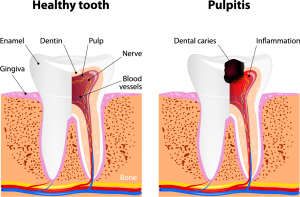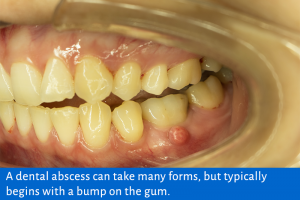How does a Cavity Form?
Learn why filling a cavity is the best possible scenario compared to other options!
There are 5 Stages of Tooth Decay
Did you know there are five distinct stages of tooth decay? And, that in the first stage of decay, you can take steps to reverse the progression of the disease? Indeed, it’s true. In the first stage of decay, whether you’re a child or an adult, the application of fluoride via fluoride treatments, your toothpaste, and even the local water supply can stop a cavity from penetrating through the enamel and reaching its second stage.
Even the saliva in your mouth and the foods you eat help to re-mineralize a tooth in jeopardy. But that’s just the first stage! What about the rest? Understanding how a cavity progresses can assist you in preventing each successive stage from occurring.
Stage One: Early Stage of Tooth Decay
White spots can be an early sign of tooth decay. This happens due to the attack of sugars and acids. These spots will begin to materialize just below the surface of the enamel. Its representative of the demineralization of the tooth and can be easy to miss to the naked eye.
A oral exam, of course, is designed to catch such cavities! Dr. Jonathan Hale, DDS, can identify and repair without any problems during this stage!
Stage Two:
The decay attacks the enamel of your tooth. Initially, the tooth erodes from the underside outward, so the outer enamel will still be intact for the first half of this second stage. Once the cavity breaks through the surface of the enamel, there is no turning back. At this point, a composite filling is necessary.
Stage Three:
Dentin Decay. If a cavity unknowingly progresses beyond stage two, it wouldn’t take long before sensitivity in that tooth, or surrounding teeth develop. At this level, the cavity begins to eat away at the second level of tooth material beneath the enamel: the dentin. Still, at this stage, Dr. Hale will propose a filling to restore the tooth and prevent the cavity from reaching the tooth’s most critical component: the pulp.
Stage Four:
Involvement of The Pulp. Once the cavity reaches the pulp, it’s going to hurt—a lot. So, if you’ve unfortunately missed all the signs to this point, a screaming child, moaning teenager, or grumpy adult will undoubtedly show more obvious signs of pain. Stage four is severe, and a root canal is the only treatment option, save for complete extraction.
Stage Five: Pain in Tooth
Abscess Formation. It is as painful as it sounds (and looks!). In the fifth and final stage of a cavity, the infection goes deep inside the tooth. It can infect the surrounding tissue and possibly the bone structure. There may be swelling, and sometimes the pain goes away, while other times, the pain is even more severe. An abscess can be fatal in both children and adults if left untreated. You need to see a dentist near you in this type of emergency. There are a few options for treatment at this stage, and we recommend talking directly to a qualified dentist such as Dr. Jonathan Hale, DDS.
When a tooth reaches Stage Five of Dental Decay, it may require a root canal or extraction. This advanced stage results from untreated cavities and decay, leading to severe tooth damage, infection, or inflammation.
It’s crucial to be aware of the consequences of neglecting dental issues. Poor oral care can cause toothaches, sensitivity, and more severe problems like abscesses and tooth loss. Preventing decay is essential through regular oral hygiene, dental check-ups, and cleanings.
If you suspect a cavity or discomfort, consult your dentist promptly to avoid invasive treatments. By practicing good oral care and seeking timely dental attention, you can maintain a healthy smile and protect your teeth.
As you can see, cavities don’t happen overnight. In the early stages, regular visits can stall and reverse the progression of these dastardly little devils, so it does pay to visit us regularly.
If you suspect you need a cavity filling in your mouth or worse a dental abscess, please contact our office. In the meantime, read our tips on managing a toothache at home.




